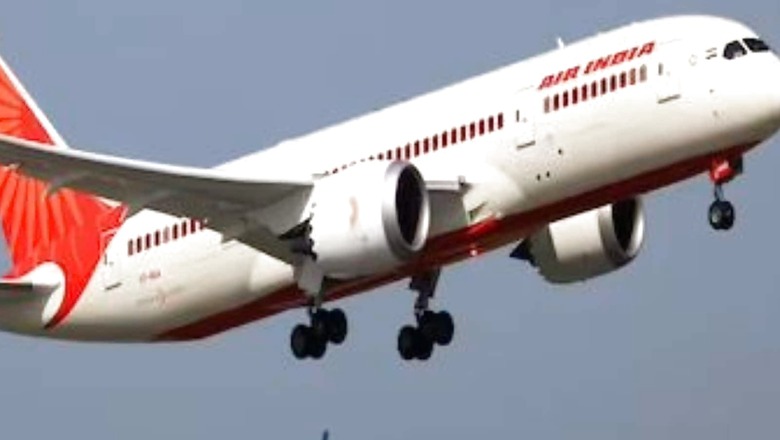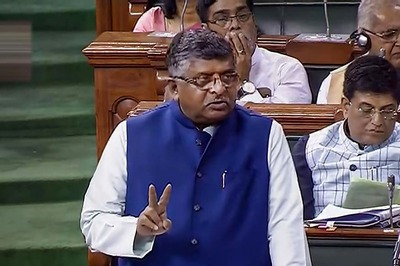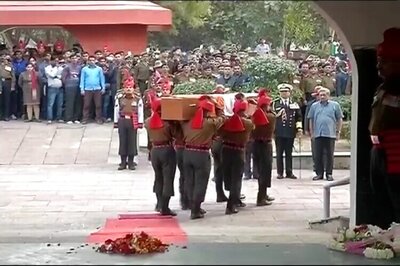
views
A country can take bold decisions only when it can stand on its own feet (aatmanirbhar), and when India makes such a call, it does so because it has made itself that strong to be able to do it. The aviation barons have no choice but to step in when Europe finds itself in the gravest economic turmoil in decades and the rest of the world reels under recession, political upheaval, or natural calamities. The biggest plane makers in the world — Boeing and Airbus — hope to survive if their business with India further increases.
In Air India, the world is today witnessing the difference between a first-class private company and a government-owned public enterprise. It was once bleeding, totally flawed, mismanaged and abused by all. Now, the Indian flag flies proudly with the Maharaja with folded hands as a picture of humility, soaring high on global skies. This is just the beginning of a renaissance for Indian aviation.
Airlines in India have placed orders for over 1,600 aeroplanes over the next two years, including a 500-plane order from IndiGo, the country’s biggest airline.
The Akasa airline, which is less than a year old, will add three more planes, primarily the Boeing 737 MAX, to its fleet within the next three months to reach 20. Sensing a solid demand despite high ticket prices, Akasa focuses on connecting Tier II cities with the country’s major metros. Besides, it will become eligible to fly to international destinations in South Asia, Southeast Asia and the Middle East. It has taken delivery of 17 aeroplanes out of 72, to be delivered by March 2027.
Air India has also placed orders with Boeing and Airbus for 470 new aircraft, the largest by a single entity. Air India looks to revamp its ageing fleet to capitalise on the travel boom in the country. Air India’s super deal is an attempt to expand India’s aviation industry.
Yet, the naysayers view the step as wrong since it will result in massive forex outgo. They opine that the aircraft purchase is not an immediate requirement for Air India. It is a misadventure similar to Tata Group’s acquisition of Tata Steel Europe, where Tata group still pays a pension to over 10,000 European workers.
Despite criticism, the Tatas seem to have worked their arithmetic well, with a clear idea of going ahead with the purchase since they are getting it at the best prices during a recession and, thanks to the present visionary government, there is now a tremendous increase in emphasis on developing aviation infrastructure in the country. More and more airports are coming up as existing airports run at total capacity. India is on its wings now and has progressive plans for significant upgrades and expansion of metro city airports. Success comes to those who dare and seldom to the timid. The Tatas will do whatever it takes to re-establish the Maharaja.
For IndiGo, Akasa and the Tatas, it’s heartening to note that much more Indians are now flying regularly, which is showing a marked improvement in the overall economy against the background of recessionary trends globally. An increase in airports and air travel has helped the development of associated facilities and job creation and improved lifestyle, thereby increasing the country’s GDP.
Earlier, foreign players like Emirates and Qatar Airways successfully grew their business in Indian skies as Air India was under government ownership. The Indian airlines are set to win back the lost traffic and business.
India is destined to become one of the biggest international hubs and a geopolitical tour de force as several favourable factors–like a unique strategic location and population size, IT backup and skilled human resources–have remained untapped for several years in the past. Such steps should have industrial spin-offs and active cooperation in other sectors.
The recent developments come as travel demand in India has surged post Covid, making it the world’s most rapidly growing aviation market. The capacity has surpassed 2019 levels and passenger numbers are also inching close.
Since India is viewed as the world’s fastest-growing aviation market, the Indian commercial fleet could quadruple by 2041 from 2019. As such, Boeing has evinced interest in the need for a strong service network in India or a hub for maintenance and repair operations (MRO), which will cater to the needs of the South Asian region.
Boeing may invest $24 million in a logistics park and separately set up a support centre for airlines near New Delhi. The aviation deal is reflective of many changing geopolitical scenarios and priorities and points to strategies that are going to be quake-shifting. The deal is worth more than the GDP of 140 countries. It is twice the Chinese investment in CPEC! This will have a massive impact on the kind of employment it’s going to create in the US, France, UK, as well as in Bharat. Imagine the kind of Investments these countries are going to attract.
All this amidst the global recession. Except for India, all the above-mentioned countries are seeing global recession approaching & hurting them in the very near future. This one single deal can change so many futures. For India and Atmanirbhar Bharat, the deal is a minefield of opportunity. From importers to exporters, from autos to helicopters, it won’t be long before India makes bullet trains besides commercial aircraft. The Hindustan Aeronautics Limited (HAL) helicopter factory in Tumakuru, which opened earlier this month, is one major step towards making India Atmanirbhar in aviation. It is a devoted new greenfield helicopter production unit which will improve the capacity and ecosystem to build world-class helicopters. Like the West, all major police stations and government hospitals in India need to have dedicated helicopters, helipads and related infrastructure and then be counted as modern.
This also encourages aeroplane giants to start their assembly lines in India and manufacture commercial aeroplanes. India has scaled up its activities in aviation and may surpass the global leaders in delivering quality aeronautical equipment in the years to come.
The Tatas are keen to work on more prominent partnerships with Boeing and Airbus. The intent is to bring in commercial aircraft manufacturing sometime in the future or add a final assembly line in India.
The Tata Boeing Aerospace Limited (TBAL), a joint venture (JV) between the Tatas and Boeing, has a cutting-edge 14,000 square metres facility in Hyderabad. It is a global sole source supplier for Apache fuselages and produces complex aero-structures for Boeing 737 and 777 models. According to Boeing, it has enough orders today to last beyond 2030. The recent US military order of 150 Apache, 29 Apache from Australia, expected orders from Egypt and up to 96 aircraft from Poland would translate into enough orders to go beyond 2030.
The JV rolled out its first fuselage in 2018, and since then, it has manufactured over 200 fuselages from Hyderabad. Boeing has already supplied Apache Attack Helicopters to the Indian Air Force (IAF) and shall also supply the first of six Apache helicopters to the Indian Army by the first quarter of 2024.
A Tata-Airbus joint venture at Vadodara in Gujarat shall manufacture the C-295 transport military aircraft for the IAF. It is an 80-billion-dollar deal. Does it mean that apart from Atmanirbhar Bharat, the deal achieves many other economic and non-economic goals? It has won over the arms lobby by throwing this $80 billion carrot to it, and the mouth of the deep state is stuffed with money to allow India to take action, which has prevented it after losing a portion to Pakistan’s occupation in Kashmir.
Beginning and fructification of new corporate power convergence and separation of responsibilities with Adani controlling Indian Ocean port, Ambani and Reliance retail and communication, space by Sunil Mittal, self-reliance in arms and ammunition by Tatas, along with complete control over aviation. India, with a lot of emerging aviation hubs, will be at the cusp of heralding a major transport revolution in Asia as well as the whole of the world with attendant forward and backward linkages for the new age migrant Indians and spreading their diaspora (soft power) throughout the world. Doesn’t that also mean now that India will have more bargaining power with Russia, increasing clout in West Asia, ‘grade separation’ for China along with a distinct edge, free trade agreement (FTA) with the UK in its own favour, accelerated and increased bleeding of Pakistan financially and a link to break Pakistan into six segments and taking possession of PoK back? And a step ahead, if this deal or part of the deal takes place in Indian currency, then the superpower situation for India is beyond recognition and imagination.
K Siddhartha is a strategic thinker, geostrategist, knowledge and perception management consultant, thought leadership trainer, and advisor to several International and state governments; Naleen Chandra is also a strategic thinker. Views expressed are personal.
Read all the Latest Opinions here



















Comments
0 comment